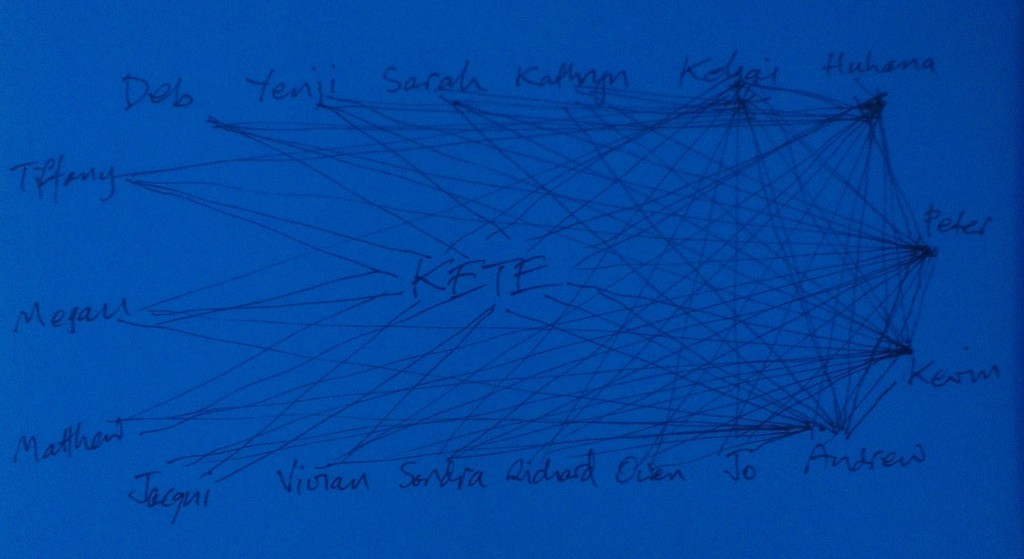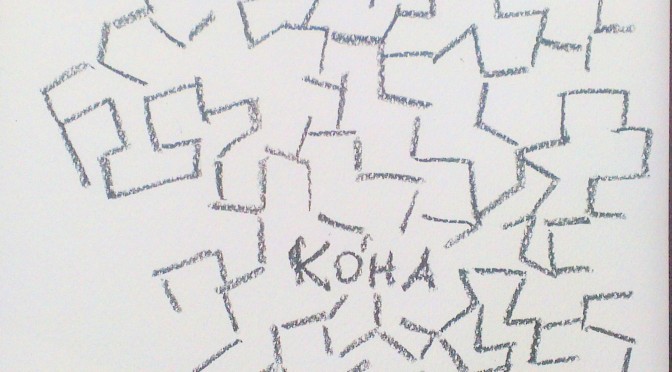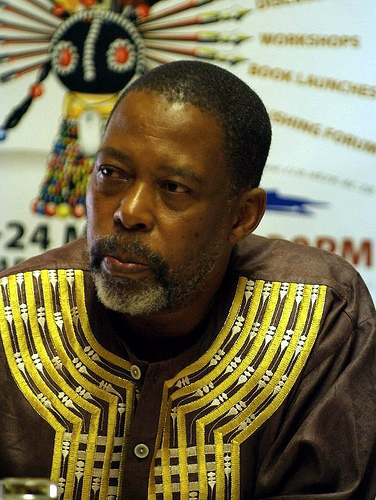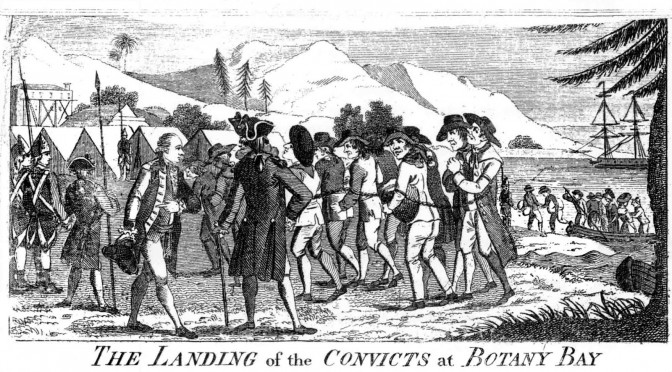
Drawing from Wellington Roundtable
On the morning of Thursday 27 February, 24 people gathered in Wellington to discuss how we can give art away. This roundtable was part of Kete, a biannual craft fair organised by the NZ Academy of the Arts. It was also the first in a series of meeting in South Ways, a project to identify and develop forms of creative practice that have a particular home in the South.
Wellington was an important place to begin this discussion (see background of the key word Bestow). It is the location of Te Papa, a museum whose brief involves the care for precious taonga, Māori treasures deserving special respect for their connection with ancestors and tribal life. It is also the site of vibrant artistic scene, including a community of contemporary jewellers who operate outside the gallery system. The roundtable was a space to stories from both sides about the dynamics involved in gifting art objects. Emerging from this are ideas for platforms that might support this practice.

Artist badge from the Free Time (Sarah Read) toolkit by Jhana Millers, 2012 (Visa Prezzy card, bronze)
Art that is given carries a meaning that is different to art that is bought and sold. How can we make a space for this while acknowledging our dependence on money to survive in the current world?
Here is a summary of the discussion:
The art of give and take
Gifting is an important means of creating relationships, particularly in Māori culture. The practice of koha cements relationships within iwi and between generations. For koha and other gifting practices, much depends not only the attitude of the giver, but also on the way it is received.
For contemporary jewellers, gifting and exchange has become an important means of sustaining its community of fellow artists. Newly emerging social practitioners are seeking to expand the circle of gifting to include the general public. This offers a counterpoint to the process of commodification that continues to deplete the public domain.
The issue they face is the potential lack of control over the disposition of the public. The danger is that these gifts are seen as ‘freebies’. A challenge is to find frameworks in which objects might circulate into the public domain without too quickly being absorbed into private consumption. It is important to create spaces that involve mutual respect between audience and artist.

Jacqui Chan, Host A Brooch, urban jewellery project, Christchurch 2011, participant's photograph.
Proposal for a Festival
One way of framing the event so that strangers might be open to a gift is to declare a certain number of days when people are encouraged to give and receive gifts. These gifts would be tokens of connection rather than consumer goods. This has potential to enliven a city, making inhabitants more aware of each other. They can also create solidarity for particular causes or groups. This Festival could be supported by a city such as Wellington so that artists would be paid to set up participatory projects in which:
- members of public would wear items of jewellery walking through the city
- jewellery that was made from the city
- jewellery made for the city
Some general points from the roundtable:
Gift
- A gift can involve extreme honesty. They can be loaded with meaning from the giver and responsibility from the receiver. Sometimes they can even stand in for the person who gave them.
- Gifts have a ripple effect.

Huhana Smith, Senior Curator Māori Museum of New Zealand Te Papa Tongarewa and Associate Curator Joe Horse Capture from Minneapolis Institute of Art. Curators kindly allowed the perspex to be removed from the poutokomanawa. It was an unforgettable experience, because no Māori visual culture scholars to the best of my knowledge then, knew where this taonga had ended up.
Taonga
The receiver can have important responsibility. For example, in 1922 the Prince of Wales was given a Mere Pounamu presented with the blade first as a sign of kaupaki to establish an ongoing relationship. The idea was that it would be given back, which the Prince failed to appreciate.
There is the money market and Māori market. Less important things are made for money.

Koha Kilohertz "My Te Reo (Maori language)classmates organized a koha for me to make a koha for Hoani, our tutor. I organized a koha for Ewan Duff (local Maori stone carver)who kohad the pounamu to me." Andrew Last
Koha
- Māori are very generous.
- Koha cements relationships. It helps keep the relationship a living one.
- It isn’t the object, it is the spirit in which it is given.
- The word koha relates to oha ti, or someone’s last words. This is a message of generosity as part of our very being.
- Koha is reciprocal. There’s a message that goes with it, an instruction of some sort
- It can’t be too small or too big.
- Gifts are ways of marking a particular moment.
- They can wait for a long time before reciprocation.
- Gifts mark connection to this place. It can be important for new-comers to feel at home here.
- The principles of koha are now taught in New Zealand tertiary institutions, involving a visit to a marae.

Joanna Zellmer 8 portraits from a jeweller’s point of view, From the series “signs in a state of change”, archival satin fine art paper, box framed, each 520 x 390 x 45mm
Contemporary jewellery
- There is a very strong sense of community in New Zealand’s contemporary jewellery scene.
- But there is a need to challenge this by broadening its audience to include people outside contemporary jewellery.
Social practitioner
- The social practitioner is an artist who develops connections between people through art works and objects. A number of contemporary jewellers could be seen to be working in this way now too.
- It involves making art available to everyone. Support for this is gained from both museums and social agencies.
- It can be informed by Buddhist principle of being effective in the world
- Sometimes it is important to lend rather than give objects. In that way there is less focus on the object itself and more how it opens up the world around you.
- Given the lack of saleable product, for some it can involve going to the path of a monastery. This could be living on home-grown vegies in the Coromandels.
- But there is a danger of an audience that doesn’t respect the art offered as gift. This is sometimes encouraged by the ‘art as fun park’ attitude encouraged by recent biennale culture.

Other proposals
Existing projects in New Zealand
- Cuckoo a New Zealand artist collective that organise events in other institutions according to a principle that no money is ever involved
- Host a Brooch
- See Here
- Organisation that brokers spaces for artists to work in vacant shopfronts
Other possible
- Crowd-funding not so relevant in New Zealand because people aren’t as wealthy as in Australia
- Cooperative where members would pay an annual fee to borrow works by artists and jewellers
Voices:
Andrew Last; Birgit Moffatt; Carol Mayer; Deborah Donnelly; Elsa Krasniansky; Helen Donnelly; Huhana Smith; Jacqui Chan; Joanna Mere Branthwaite; Johanna Zellmer; Katheryn Yeats; Kevin Murray; Kohai Grace; Laura Porterhouse; Matthew Wilson; Megan Tamati-Quennell; Owen Mapp; Peter Deckers; Richard Reddaway; Sandra Alfoldy; Sarah Read; Tiffany Singh; Vivien Atkinson; Yenji Chen.













